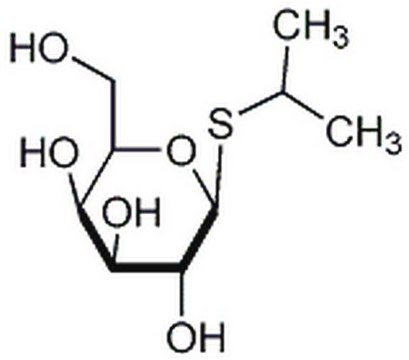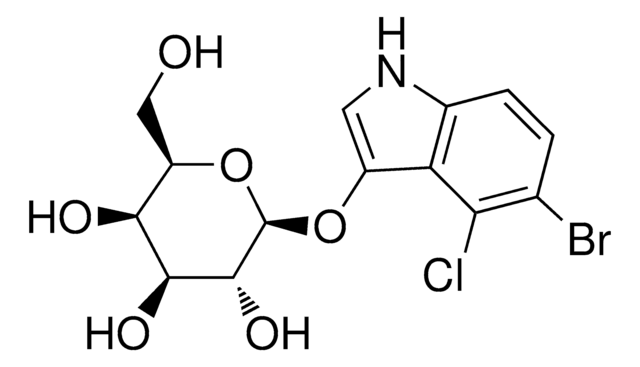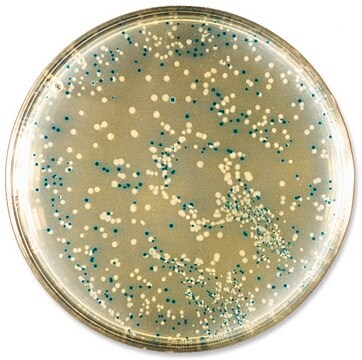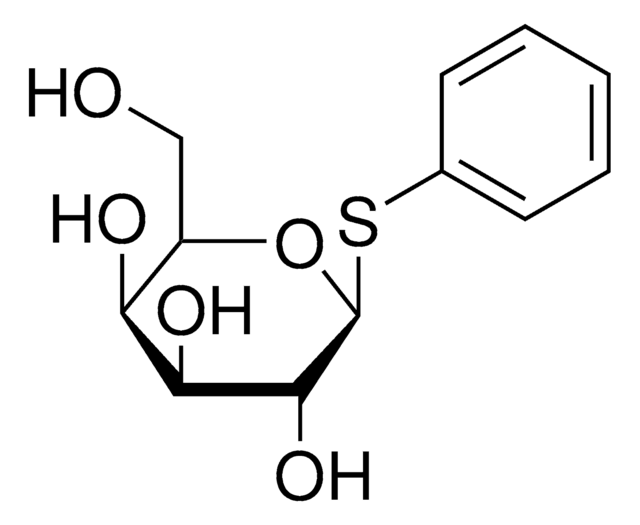Key Documents
I6758
IPTG
≥99% (TLC), ≤0.1% Dioxane
Synonim(y):
Isopropyl β-D-1-thiogalactopyranoside, IPTG, Isopropyl β-D-thiogalactoside
About This Item
Polecane produkty
pochodzenie biologiczne
synthetic
Poziom jakości
opis
non-ionic
Próba
≥99% (TLC)
Postać
powder
metody
thin layer chromatography (TLC): suitable
zanieczyszczenia
≤0.1% Dioxane
kolor
white to off-white
przydatny zakres pH
5-7 (50 g/L)
mp
105 °C ((221 °F))
rozpuszczalność
water: 0.05 g/L, clear
Zastosowanie
cell analysis
life science and biopharma
temp. przechowywania
2-8°C
ciąg SMILES
CC(C)S[C@@H]1OC(CO)[C@H](O)C(O)[C@H]1O
InChI
1S/C9H18O5S/c1-4(2)15-9-8(13)7(12)6(11)5(3-10)14-9/h4-13H,3H2,1-2H3/t5-,6+,7+,8-,9+/m1/s1
Klucz InChI
BPHPUYQFMNQIOC-NXRLNHOXSA-N
Szukasz podobnych produktów? Odwiedź Przewodnik dotyczący porównywania produktów
Opis ogólny
Zastosowanie
- in the induction of protein expression in Lactobacillus reuteri GroEL and mutants
- in the induction of protein expression in Escherichia coli
Działania biochem./fizjol.
Inne uwagi
Rekonstytucja
produkt podobny
Hasło ostrzegawcze
Danger
Zwroty wskazujące rodzaj zagrożenia
Zwroty wskazujące środki ostrożności
Klasyfikacja zagrożeń
Carc. 1B
Kod klasy składowania
6.1C - Combustible acute toxic Cat.3 / toxic compounds or compounds which causing chronic effects
Klasa zagrożenia wodnego (WGK)
WGK 3
Temperatura zapłonu (°F)
Not applicable
Temperatura zapłonu (°C)
Not applicable
Środki ochrony indywidualnej
Eyeshields, Gloves, type N95 (US)
Wybierz jedną z najnowszych wersji:
Certyfikaty analizy (CoA)
Nie widzisz odpowiedniej wersji?
Jeśli potrzebujesz konkretnej wersji, możesz wyszukać konkretny certyfikat według numeru partii lub serii.
Masz już ten produkt?
Dokumenty związane z niedawno zakupionymi produktami zostały zamieszczone w Bibliotece dokumentów.
Klienci oglądali również te produkty
Produkty
Ogólne protokoły wzrostu komórek kompetentnych i ich transformacji (pobieranie DNA).
General protocols for growth of competent cells and their transformation (uptake of DNA).
Protokoły
Hodowla bakterii E. coli w skali od małych kultur do fermentacji. Uwzględniono protokoły inicjowania kultury starterowej, komórek zawiesinowych, monokultury i posiewu bakteriofaga M13.
General protocols for growth of competent cells in microbial medium.
Nasz zespół naukowców ma doświadczenie we wszystkich obszarach badań, w tym w naukach przyrodniczych, materiałoznawstwie, syntezie chemicznej, chromatografii, analityce i wielu innych dziedzinach.
Skontaktuj się z zespołem ds. pomocy technicznej










